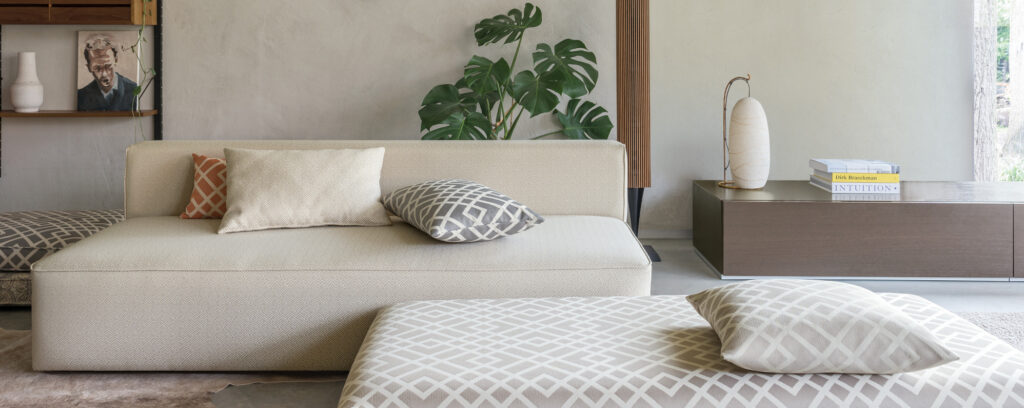This is Japandi (A mash-up of elegant Japanese minimalism and rustic Scandinavian simplicity)
It's 2025, and Japandi style isn't just surviving - it's thriving. As upholstery experts at FibreGuard, we're more excited than ever about this enduring design movement. Today we’re looking at the defining elements of Scandinavian design and Japanese minimalism, and how we’re seeing it play out this year in upholstery and drapery fabrics.
Like mid-century modern design, this fusion of Japanese minimalism and Scandinavian functionality has proven its staying power. With a focus on clean lines and solid artisanship, Japandi décor combines the best of the two design philosophies. Check out these two beautiful ‘Japandi’ style homes (CASE STUDY) that feature our easy-clean upholstery for more insights.
Ok, ready? Let's start. Here’s the rundown on both styles:




Key Elements of Scandinavian Design
Hygge
Hygge (pronounced "hoo-gah") is a Danish and Norwegian idea that captures the essence of coziness, comfort, and happiness through everyday moments and simple joys.
“Hygge is about enjoying the process. About taking things slowly. And looking forward to the delicious results you will enjoy tucked up at home on a quiet wintry evening. It’s about enriching this time at home by knowing that you’ve got plenty of delights in store, ready for the perfect hygge moment. It’s about making your nights in special, and never feeling that you are missing out.” ― Meik Wiking, My Hygge Home: How to Make Home Your Happy Place
Scandinavian design embraces the hygge philosophy at its core, creating spaces that radiate bright, clean warmth. Natural light plays an important role, with large windows, minimal window treatments, and strategic mirror placement helping to maximise brightness.
Pale wood and multipurpose furniture
The use of pale woods like beech and ash is a key trait of this style, with light-coloured timber appearing in both furniture and flooring. Functional minimalism defines the furniture choices, where practical, multi-purpose pieces showcase clean lines and simple forms.
Scandinavian colour schemes
Colour schemes typically feature predominantly white bases complemented by soft, natural colour accents. We’re seeing this in the popularity of whites, off-whites and warm neutrals.
"Form follows function in Scandinavian design, but is frequently defined by an organic, even humanistic approach to modernism." - Hans Wegner
Textural textile touches in Scandinavian design
Textural contrast adds depth through the thoughtful layering of natural materials – you'll often find wool, linen, leather, and wood working in harmony. The connection between indoor and outdoor spaces remains important, with plants and natural elements incorporated throughout the design.


Essential Japanese Minimalist Elements
Japanese minimalism is both an architectural design movement and a philosophy rooted in traditions like Shintoism and Buddhism. It’s all about rejecting mindless consumption, instead encouraging a focus on the inner self. Its outward forms are characterised by simplicity, minimalistic expression, and clear, intentional design.
Beauty in imperfection
Japanese minimalism centres on the idea of beauty in imperfection, or Wabi-Sabi (see: Wabi-sabi: the stress-free design style we need). This philosophy works hand in hand with the concept of ma, or negative space, where empty space becomes a conscious design element that brings balance and harmony to interiors.
Natural colours, materials and textures
The Japandi colour palette draws inspiration from nature, featuring a sophisticated range of neutral tones. Whites, creams, soft beiges, and pale greys create a serene backdrop, while deeper earth tones add depth and grounding elements. Like Scandinavian design, Japanese minimalists lean into the sense of touch too, often combining different textile surfaces – from linen-like textured designs to chunkier weaves and slubbed yarns.
This interplay of textures adds dimension to spaces without overwhelming them.
Low profile, Japanese-style furniture
This authenticity extends to furniture choices, where low-profile pieces, particularly ground-level or low-height seating and tables, create a sense of groundedness and tranquillity.
"I believe that design is about creating a sense of calm and comfort, a sense of belonging." - Naoto Fukasawa



2025 tips and predictions for Japandi style interiors and textile trends
Textiles play a big role in creating authentic Japandi spaces. Natural materials, slubbed materials and fibre blends take centre stage, with cotton, linen, and wool-feels serving as the primary elements that bring warmth. FibreGuard's commitment to sustainable textile production aligns effortlessly with Japandi's eco-conscious principles, offering materials that are not only beautiful but also environmentally responsible.
The way one looks at things is of the utmost importance. Seeing is feeling with the eyes. – Axel Vervoordt, What You Need to Know About Belgian Style Interior Design
What kinds of fabrics do we recommend? Well:
- Flatwoven upholstery fabrics, for example, are great at bringing an earthy feel to a room. Their nubby, irregular surface provides visual interest and appeals to our sense of touch.
- Subtly textured upholstery also boosts the relaxed appeal of Japandi, adding a very light tactile quality that won’t overpower the warm minimalist aesthetic.
- Slubbed fabrics: When weavers intentionally add inconsistency to the look of their fabric by varying the thickness of their threads, they create slubbed fabrics. The result is a beautifully uneven texture and appearance (sometimes referred to as “slubbiness”) that usually adds warmth and comfort to whatever space it’s used in: think blankets, cushions or curtains just to name a few!
- A range of earthy colours and soft neutrals: Woven plains in plum, granite and sage are perfect for Japandi décor because they form a calm backdrop for layers of richer textures. Choose from shades such as muddy brown and moss green, as well as calming neutrals including taupe and sage. FibreGuard upholstery is perfect for Japandi style living, because it's low maintenance and beautiful—especially in neutral shades. Further ideas: How to combine fabrics, textures, and colours for a peaceful Japandi style
FibreGuard upholstery makes a perfect partner for Japandi style spaces
Japandi style just doesn’t seem to be going away any time soon, which is good news for design enthusiasts. Before we go, we encourage you to explore more of our FibreGuard Japandi-inspired content and visit our Pinterest board.
See you next week!